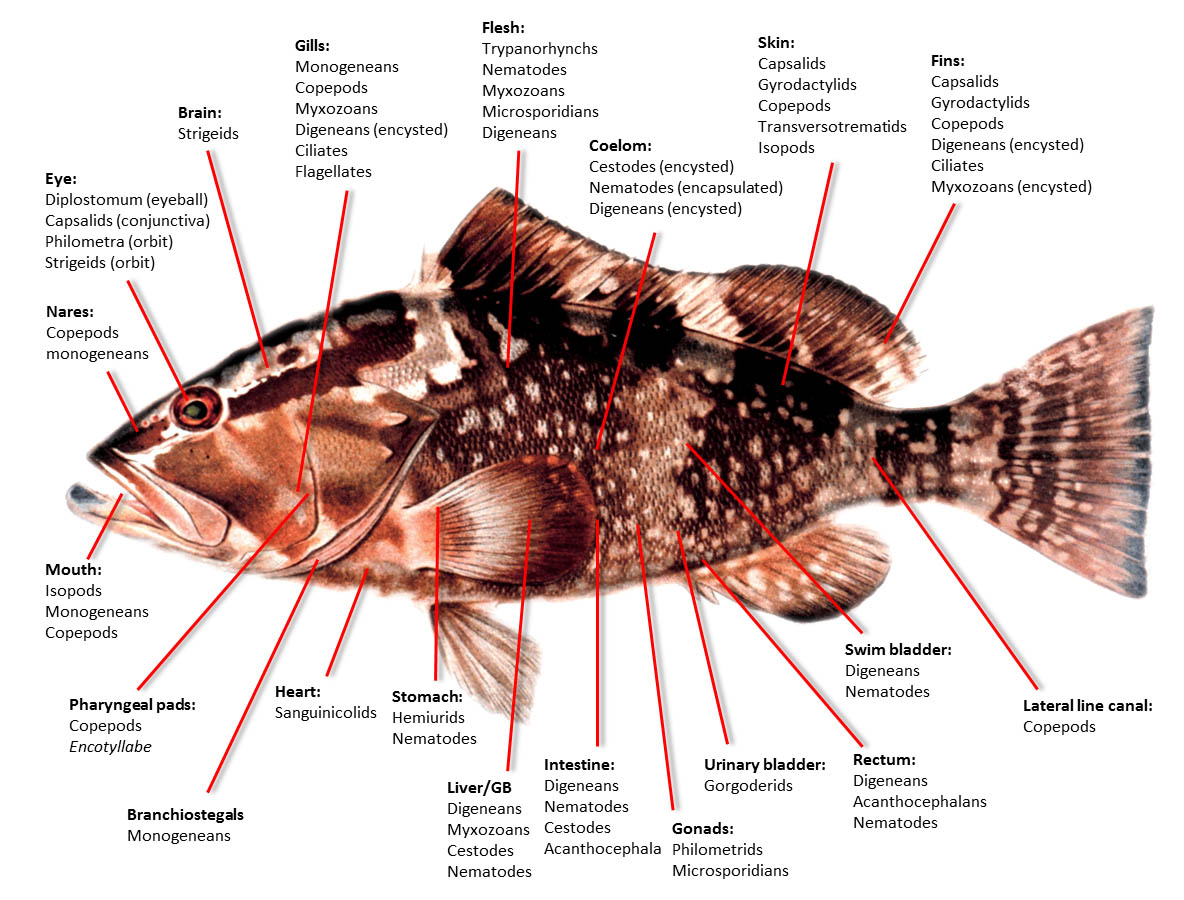Let's start with a handy graphic showing you how absolutely infested a typical fish is with parasites.
 |
A guide to parasites on a typical fish |
your average fish is, to parasites, a diverse palette of microhabitats, all of which are ripe for the exploiting for the cost of a few specialized adaptations. If you look hard enough, you’ll find something living in most of these microhabitats, in most species of fishes. -- Alistar Dove
And the thing is, in typical, healthy, functional ecologies, parasites are EVERYWHERE. Such infestation is not usually a sign of ecological poor health.
How many parasites?
From Poulin, Robert, and Serge Morand, ‘The Diversity of Parasites’, The Quarterly Review of Biology, 75.3 (2000), 277–93 <https://doi.org/10/cprhdc>.There are many species of parasites. If we define "parasite" as "a creature that, at some point in their life-cycle, has to feed on another creature, without killing it",
then almost 50% of known animal species can be classified as parasites. Stricter definitions, in which an organism must live on or in its host for a significant portion of its life to be considered a parasite, would yield more modest estimates. The number of parasites is still likely to be huge, however, given that probably only 10 to 20% of all existing kinds of organisms are known to science (May 1986; Hammond 1992), and that practically all free-living metazoans harbor at least one parasite species.
On the tree of life, parasites are everywhere, on most of the major branches (phyla).
Parasitism by metazoans on other metazoans--the focus of this review--has evolved independently at least 60 times in the evolutionary history of animal life on Earth (Table 1)... Parasitism has evolved on at least as many (if not more) occasions than other modes of life, such as predation. Furthermore, several parasite lineages have diversified greatly over evolutionary time, and are now represented by large numbers of distinct species (Table 1). In some instances, parasitic lineages have diversified more than their free-living relatives.
From Dobson et al, ‘Homage to Linnaeus: How Many Parasites? How Many Hosts?’, Proceedings of the National Academy of Sciences, 105.Supplement 1 (2008), 11482–89 <https://doi.org/10/bcn9dr>
there are at least 50% more parasitic helminth species (~75,000) than there are vertebrate hosts (45,000)... considerations of cryptic species might well lead to a further doubling of the estimates of global parasite richness, suggesting that there could be 300,000 parasitic helminth species using vertebrates as hosts.
From Parasitic castration: the evolution and ecology of body snatchers (2009), parasitic castrators are particularly prevalent in some ecologies.
The pooled biomass of parasitic castrators was 3–11 kg/ha, which exceeded the biomass of the macroparasites by two orders of magnitude. The biomass of parasitic castrators even surpassed the biomass of top predators (mostly shorebirds) in two of the three estuaries.
Embrace the parasites (not literally)
From Parasites Affect Food Web Structure Primarily through Increased Diversity and Complexity (2013), parasites increase the complexity of ecologies, and their contribution cannot be replaced by non-parasitic predators:
adding parasites usually increases link density and connectance (simple measures of complexity), particularly when including concomitant links (links from predators to parasites of their prey)... parasites do appear to alter structure in ways that result from unique traits—in particular, their close physical intimacy with their hosts, their complex life cycles, and their small body sizes.
In other words, parasites sing a unique note in the harmony of nature.

No comments:
Post a Comment